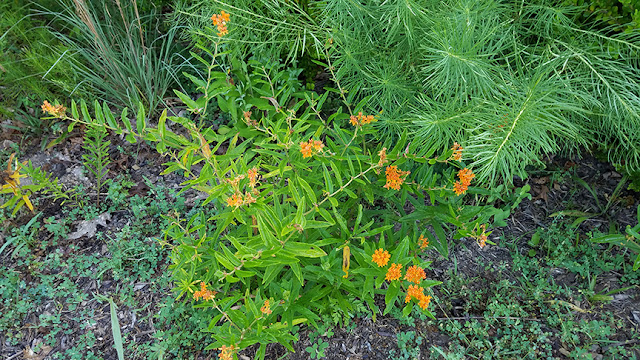 |
| My back yard in July. |
It's July Bloom Day, hosted by Carol Michel's May Dreams Garden Blog on the 15th of every month. Welcome to my Zone 6B Virginia garden! It's amazing to contemplate nature's bounty when I look out from my deck on this lovely summer morning at 6:00 AM, and think back to some thirteen years ago when my husband and I bought the property... this was all just an empty expanse of weedy grass.
 |
| Looking west from the deck. |
 |
| Looking east, the vegetable pagoda and Herb's bed. |
The grass is still weedy, but as for the rest, what a change! It's taken a lot of hard work, heartbreaking trial and error to bring what you see here into being. And yet, my garden is young by garden standards--my trees are still small. I've done it mostly by myself, with a bit of help from Herb. It's finally starting to look like the garden I had envisioned, despite the deer's voracity, three years of drought, and seventeen-year locusts. This year's plenteous rains have done wonders for it. Let's get down and take a closer look at what's blooming.
 |
| Agapanthus 'Blue Nile' |
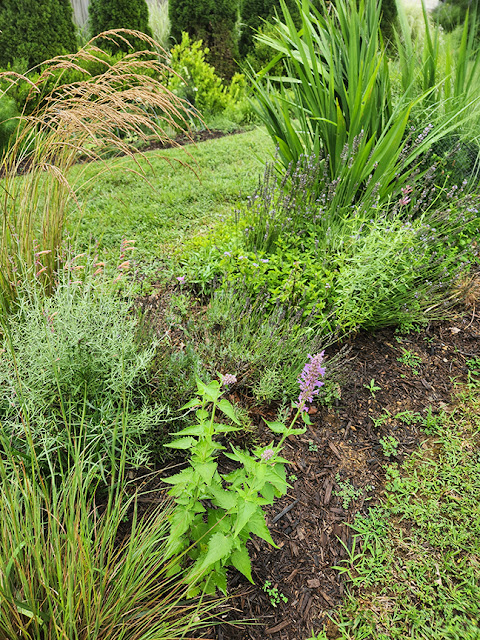 |
| Agastache 'Blue Boa, 'Apache Sunset' and 'Pink Pearl' with 'Karl Foerster' feather reed grass. |
The Agapanthus 'Blue Nile' in Herb's bed is blooming, along with Clary sage and 'Texas Red' sage. Farther back in the same bed, my three Agastaches are also starting to bloom--'Blue Boa', 'Apache Sunset' and a pink one I think is 'Pink Pearl'. For some reason, despite growing for several years and re-seeding, 'Blue Boa' doesn't seem to want to spread much--it should be much larger by now!
 |
| Vitex (Vitex agnus-castus) shrub in east garden. |
 |
| Bottlebrush Buckeye (Aesculus parviflora) |
 |
| Bottlebrush Buckeye flowers close up. |
My Vitex shrub, AKA the Chaste tree or summer lilac, is in full bloom--I love the cooling effect of the color.
The native Bottlebrush Buckeye comes into its own at this time too. The airy delicate spikes are loved by butterflies and hummingbirds. Speaking of which, we saw a hummer buzzing the Clary sage--had no idea they'd go for this sage which has such a medicinal aroma.
 |
| Butterfly bush (Buddleja davidii) and Butterfly weed (Asclepias tuberosa) |
The Butterfly bush is growing back well despite a huge set-back this spring from an April frost right after a hard pruning.
 |
| Coneflowers in the back bed. |
 |
| Hybrid daylily. |
The deer left me a few coneflowers in the back bed (orange Sombrero I think) and one lone daylily flower--I spray them with deer repellent regularly, but they eat the buds anyway. They've also eaten every bud of the wild Bergamot I planted from seed last year. I thought that Monardas wouldn't be particularly palatable to deer, being in the mint family, but they eat the red 'Jacob Cline', while the Anise hyssop and narrow-leaved mountain mint are not to their liking. I'm gradually becoming an expert on deer-impervious plants.
 |
| Mountain mint, Anise hyssop, Monarda 'Jacob Cline' and oat grass. |
This year I grew some Cleomes from seed, but only three plants survived--very pretty annuals,though, I'd like to try them again next year--perhaps they'll oblige and re-seed themselves?
 |
| Spider plant (Cleome) |
 |
| West foundation plantings: Salvia yangii (formerly Russian sage), Catmint and one Cleome. |
The Chinese iris in the long island bed in back is not palatable to deer, neither are the pink Dianthus or the minty green plants (some sort of wild Calamint?), but they go for the blue flowers of the bush Clematis behind. They've about extirpated my Asian lilies and finished off most of the black-eyed Susans in this bed.
My heather grows under a wire cloche, which distorts its growth, but I'd have no plant at all without it--I should prune it this fall to see if I can get rid of the leggy branches and re-shape it. But perhaps early spring is a better time to prune heather--any advice?
 |
| Chinese iris and pink Dianthus. |
 |
| Heather in bloom. |
Further down this bed a lone spike of orange Gladiolus survives under the Weeping Butterfly bush (Budlleja lindleyana). The broken upside-down flower pot is a toad-house.
 |
| Orange Gladiolus with Buddleja Lindleyana |
My potted plants on the porch are those most susceptible to deer: an avocado tree grown from seed, a bi-color leaf Sunpatiens my sister gave me, a Platycodon waiting to be planted when the weather cools, a yellow Hibiscus, purple basil, Begonias, Caladiums, succulents and other house plants that live outside during the summer. I even brought my Cattleya orchids outside in hopes of some budding.
 |
| Potted plants on the front porch. |
 |
| Plants on the porch. |
This year the hanging baskets on the porch have mostly Petunias, with red Pelargoniums and sweet potato vines. One variety of Petunia, the 'Pretty Grand mix' emits wonderful perfume at night--the dark purple ones in particular. I've never come across scented Petunias before--though some varieties I've grown before were advertised as scented, none had proved to be so until now.
 |
| Petunias 'Pretty Grand Mix' |
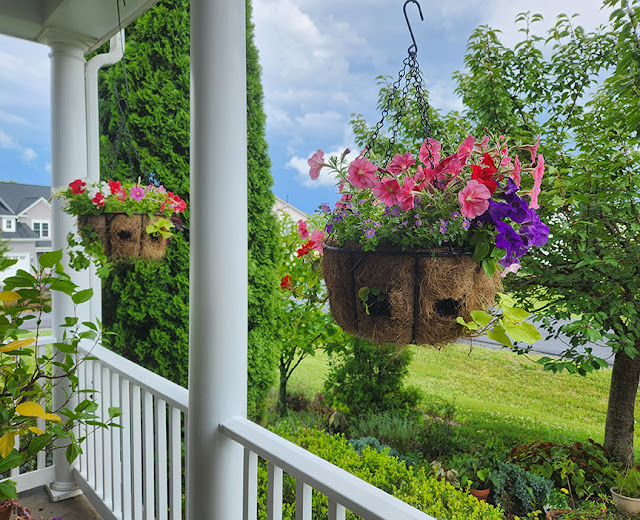 |
| Porch baskets |
Other plants bloom along the front walk: a miniature yellow Dahlia, and white Heliotrope. The Australian red finger lime is setting more fruit. The tropical salvias ' Black and Blue, 'Amistad,' and 'Faye Chapel' haven't put up much of a show yet--the deer ate all the buds of 'Faye Chapel' before they had a chance to develop!
 |
| Plants along front walk: Puya alpestris on the right. |
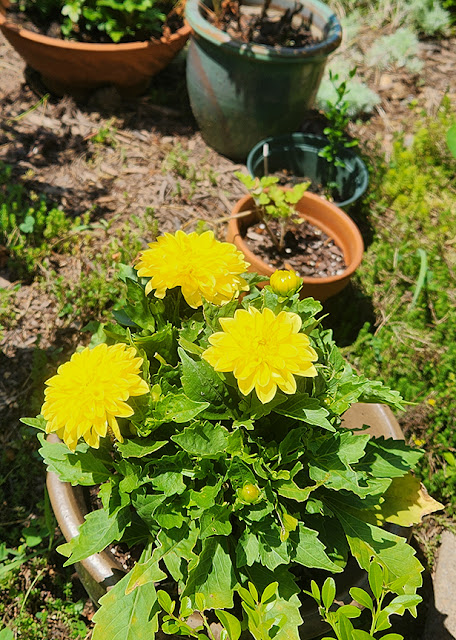 |
| Miniature yellow Dahlia. |
 |
| White Heliotrope. |
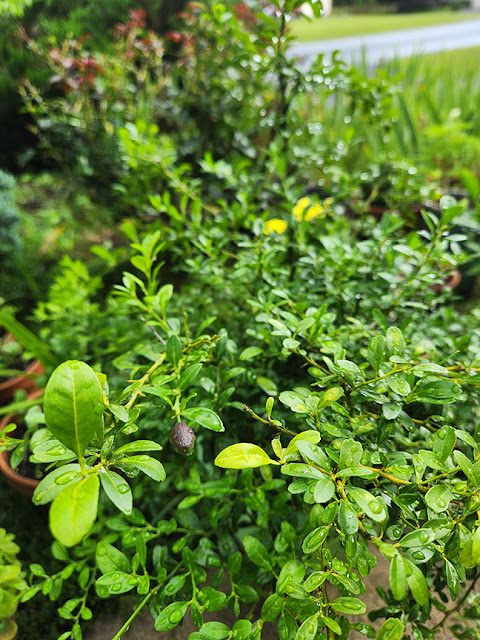 |
| Australian red finger lime |
 |
| Irish moss (Sagina subulata) by the front walk. |
Returning to where we started on the rear deck, the two Cupheas are putting on a show: 'Torpedo' and 'Honeybells.' Next week my contractor starts on the deck repairs and refinishing, so I'm trying to keep the back deck clear of plants. Ordinarily, my deck would be filled with potted plants.
 |
| Cuphea 'Torpedo' |
 |
| Cuphea 'Honeybells' |
Thanks for visiting, hope to see you next month!



